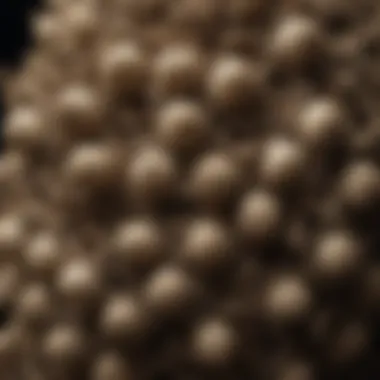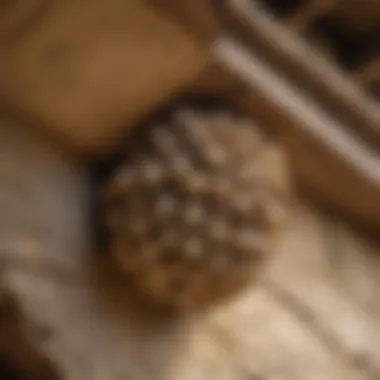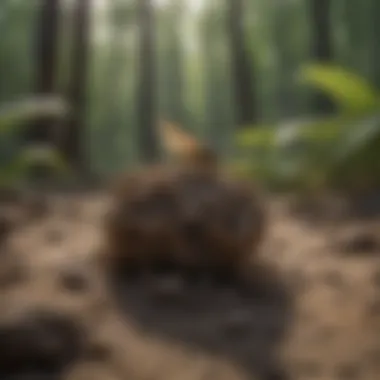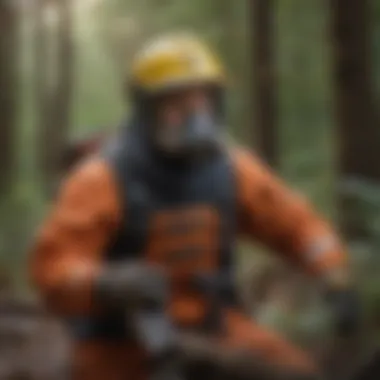Mud Wasp Nests: Effective Removal and Safety Tips


Intro
Mud wasps are fascinating creatures that play a significant role in their ecosystems. Their unique nesting behavior often causes concern for homeowners and environment lovers when their presence becomes too prominent. This guide provides a detailed understanding of mud wasp nests, delving into their habitat, effectiveness in pest control, and ways to manage their populations without harming the ecosystem.
Understanding the characteristics of mud wasp nests is key for both nature enthusiasts and forestry professionals. By examining their nests and life cycle, we can better appreciate their ecological role while also considering effective removal strategies that are environmentally sound.
In this comprehensive guide, we will cover
- basics of woodland ecosystems to set the context,
- practical solutions for mud wasp nest removal,
- and methods for ensuring that these activities align with sustainable practices.
With a focus on safety precautions and ecological awareness, this article is designed to empower you with the knowledge needed to handle mud wasp nests responsibly and effectively.
Prelude to Mud Wasps
Mud wasps play a significant role in maintaining ecological balance. Understanding these insects is crucial, especially for those engaged in outdoor activities or environmental management. This section will provide insight into their biology and importance.
Understanding Mud Wasps
Mud wasps, primarily belonging to the family Sphecidae, are solitary wasps known for their unique nesting habits. They construct nests from mud, which they gather and shape with their mandibles. These nests can be found in various environments. The species within this group include the common mud dauber, Sceliphron caementarium, which presents specific behaviors and characteristics worth noting. Their nests are usually cylindrical and can often be spotted under eaves or in sheltered areas.
Their lifecycle consists of various stages: egg, larva, pupa, and adult. Females create nests, provision them with captured prey, and lay eggs in these mud chambers. Once the larvae hatch, they feed on the stored prey, ensuring their growth and survival. The process is a clear indicator of the wasps' role in pest management within ecosystems.
Ecological Role of Mud Wasps
Mud wasps contribute to the environment in many ways. They play a valuable role in controlling pest populations. By preying on various insects, such as flies and caterpillars, they help maintain a healthy balance in nature. This predatory behavior supports plant health, reducing the need for chemical interventions in gardens and agricultural settings.
Moreover, their nests serve as homes for many other organisms once vacated. Various species of parasites and beneficial insects may inhabit these structures. Therefore, mud wasps not only contribute to pest control but also enhance biodiversity.
"Mud wasps exemplify the intricate interactions within an ecosystem, balancing pest management while offering habitat for other wildlife."
In summary, mud wasps present a multifaceted character within their environments. Recognizing their contributions allows for informed decisions regarding their removal, especially in residential areas where their presence might be considered intrusive.
Identifying Mud Wasp Nests
Identifying mud wasp nests is a critical aspect of managing their presence in both residential and natural environments. Understanding how to recognize these nests assists in determining the best approach for removal or deterrent strategies. It aids individuals in distinguishing mud wasps from other types of wasps and insects, which is vital for effective management and safety.
Being aware of the specific characteristics and locations where mud wasps build their nests enhances preparedness. This knowledge can minimize unnecessary risks associated with accidental encounters. The benefits of identifying mud wasp nests extend to fostering a more profound respect for ecological systems and their roles.
Physical Characteristics of Nests
Mud wasp nests exhibit distinct physical characteristics. Typically, these nests are constructed from mud, collected and beaten into shape by the wasps. The nests often appear somewhat like small, elongated structures attached to various surfaces.
- Color and Texture: The nests usually have a grayish-brown color and a rough texture, due to the nature of the mud used.
- Size and Shape: They can vary in size, ranging from a few centimeters to several decimeters, depending on the species. The shapes can be tubular or spherical.
- Entrance Holes: An important feature to note is the presence of round entrance holes from which the wasps enter and exit.
A keen observation of these elements can simplify the identification process. Recognizing these characteristics helps in differentiating mud wasp nests from other similar structures.


Common Locations for Nesting
Mud wasps choose specific locations to build their nests. Understanding these preferred sites can aid in early identification and management efforts. Common nesting sites include:
- Eaves and Overhangs: Often, you will find nests under the eaves of roofs or porch overhangs to protect the nests from rain and predators.
- Fences and Walls: They may attach nests to wooden structures, garden fences, or even walls.
- Natural Features: In natural settings, mud wasps favor tree trunks or rocky surfaces.
Awareness of these locations can prompt timely action, whether one opts for removal or simply monitoring the nests. Treating sections with mud nests carefully can also ensure that other beneficial insects are not inadvertently harmed.
Knowing the nesting habits of mud wasps not only helps in reducing conflicts but also in preserving the ecological balance.
Why Remove Mud Wasp Nests?
Understanding the reasons for removing mud wasp nests is essential for homeowners and nature enthusiasts alike. Mud wasps, while fascinating creatures, can pose challenges in certain environments. Their nests may disrupt human activity and lead to health concerns. This section explores the specific elements that emphasize the importance of nest removal, focusing on two primary aspects: impact on human activity and potential health risks.
Impact on Human Activity
Mud wasps often build their nests in areas where people live and work. Common locations include eaves, garages, and outdoor spaces. Their presence can lead to significant inconveniences.
- Obstruction of Spaces: Nests can occupy vital areas, reducing usable space. In highly trafficked regions, this can cause disruptions.
- Aesthetic Concerns: Unsightly nests can detract from the appearance of homes and gardens, impacting property value and appeal.
- Increased Activity: As nests develop, the number of wasps may increase. This heightened presence can lead to a more aggressive atmosphere, making outdoor activities less enjoyable.
Addressing the impact of mud wasp nests can help restore both functionality and aesthetic quality in residential areas. Their removal is often a necessary step to reclaiming a comfortable environment.
Potential Health Risks
One significant issue tied to mud wasp nests is the potential health risks they pose. While the stings of mud wasps are not as dangerous as those of some other species, they may still cause problems:
- Allergic Reactions: Some individuals experience allergic reactions to wasp stings. In severe cases, this can lead to anaphylaxis, a life-threatening condition.
- Pain and Discomfort: Even for those without allergies, wasp stings can be painful and result in swelling, posing immediate discomfort and distress.
- Potential for Disease Transmission: Like other insects, mud wasps can be vectors for disease. While not commonly associated with severe illnesses, their presence can still pose health concerns for sensitive individuals.
Effective removal of mud wasp nests is crucial to mitigate these health risks and maintain a safe living environment.
Given these factors, removal strategies become not just a matter of preference but a necessarity for ensuring safety and peace of mind. The balance between ecological awareness and practical actions must be maintained.
Safety Precautions for Removal
Removing mud wasp nests can be a perilous task that requires careful planning and execution. It is crucial to understand the risks involved during removal, primarily because mud wasps are protective of their nests. Taking safety precautions can greatly reduce the chance of stings and ensure a smoother process. Thus, this section outlines the importance of safety and the necessary measures to take prior to the removal efforts.
Protective Gear Recommendations
Protection starts with appropriate attire. Wearing suitable clothing is fundamental when approaching mud wasp nests. Here are recommendations to ensure safety during the removal:
- Long Sleeve Shirt and Pants: Choose durable and tightly woven fabric to minimize sting exposure.
- Gloves: Insulated gloves can protect your hands. Make sure they are long enough to cover the wrists.
- Face Protection: A face shield or safety goggles can provide essential protection for the eyes and face.
- Respiratory Mask: Dust masks can also be useful to avoid inhaling any potential dust disturbed during the nest removal.
These items together create a protective barrier against not only physical stings but also any allergens released during the removal process.
Timing Your Removal Efforts


Timing is crucial for successful mud wasp nest removal. Conducting the removal at the right time can minimize the likelihood of confrontation with the wasps. Here are several considerations to keep in mind:
- Optimal Time of Day: The best time to remove the nests is either early morning or late evening. During these hours, mud wasps are less active as they are more likely to be inside the nest, thus reducing the risk of encountering them.
- Seasonal Considerations: Avoid removal during the peak summer months when mud wasps are most active and aggressive. Early spring or late fall are usually ideal times to tackle nests.
- Weather Conditions: It is preferable to conduct removal on a dry day. Rainy weather can cause the nests to become saturated, making them more difficult to remove, and also increasing insect activity.
Taking these timing strategies into account can transform a hazardous undertaking into a more manageable task.
"Safety and preparation are the keystones to effectively manage mud wasp nests without incurring unnecessary risk."
Being cautious and appropriately prepared is essential. The risks associated with mud wasp nests can be mitigated through diligent safety precautions and awareness of the removal environment.
Methods of Removal
The methods of removal section is crucial as it provides practical strategies to manage mud wasp nests. Understanding these techniques is key for anyone dealing with a mud wasp infestation. Each method has its own set of benefits and considerations, making it important to choose the right approach based on the specific circumstances.
Manual Removal Techniques
Manual removal techniques require careful planning and execution. This method involves physically dismantling the mud wasp nests. It is often the most straightforward approach, but demands caution to avoid stings. Before initiating removal, ensure that the nest is inactive. Evening or early morning can be effective times since mud wasps are generally less active then.
- Gather necessary gear: Before beginning, wear protective clothing such as long sleeves, gloves, and a hat. Use a mask or goggles to protect your face and eyes.
- Dismantle the nest cautiously: Use a stick or similar tool to poke at the nest. If no wasps emerge, proceed with detaching the nest gently. Place the nest into a bag and seal it. Dispose of it away from residential areas.
- Observe and monitor: After removal, observe the area for any signs of reestablishment. It may take time, but careful monitoring is essential to ensure that wasps do not return to the same location.
Chemical Removal Options
Chemical removal options can be effective but require a measured approach. These methods involve using insecticides designed to target mud wasps directly. It is vital to select appropriate products that are safe for the environment and any surrounding wildlife.
- Choose the right insecticide: Look for products that specify effectiveness against mud wasps. Those containing pyrethroids are commonly recommended. Always read the label before application.
- Apply during low activity times: Spraying in the late evening or early morning maximizes effectiveness as the wasps are less active, reducing the risk of stings.
- Safety precautions: Wear protective gear to minimize contact with chemicals. Ensure that the area is clear of pets and people during application. Always follow up by monitoring the site for any remaining activity.
Natural Deterrent Strategies
Natural deterrent strategies offer an ecologically friendly solution for managing mud wasp nests. These methods utilize non-toxic substances or natural repellents to discourage wasps from nesting.
- Essential oils: Certain essential oils, such as peppermint or clove, can naturally repel mud wasps. Mix these oils with water in a spray bottle and apply around potential nesting sites.
- Physical barriers: Installing screens or netting can limit the access wasps have to areas where they might build nests. This proactive approach often reduces the likelihood of nest formation.
- Maintain clean environments: Keeping areas free of food scraps and waste eliminates attractants that might invite mud wasps to nest nearby. Regular cleaning can act as a gentle deterrent.
Remember, a combination of methods may yield the best results. Evaluate each option based on safety, effectiveness, and environmental impact before making a decision.
Post-Removal Considerations
Post-removal considerations are crucial in understanding how to manage mud wasp nests effectively. After you have engaged in removal efforts, there are specific elements to keep in mind to ensure that the actions taken are sustainable and do not further aggravate the situation. By addressing these considerations, one can minimize the likelihood of reestablishment and promote a healthier environment.
Monitoring for Reestablishment
After the removal of mud wasp nests, it becomes necessary to monitor the area for signs of reestablishment. Mud wasps are persistent insects, often returning to the same locations. Regular inspection ensures that any new nests are identified quickly. You should be aware of certain factors that influence their return, such as availability of resources like mud and sheltered spots for nesting.
- Frequency of Monitoring: Weekly checks for the first month can help catch new activity early.
- Indicators of Activity: Look for fresh mud structures or wasps entering and exiting potential nesting sites.
This proactive approach allows for prompt action if reestablishment occurs. Consider keeping a log to track any wasp activity and patterns. This documentation can assist in identifying hotspots and refining your removal strategy.


Ecological Impact of Removal
The ecological impact of mud wasp nest removal is another vital aspect to consider. Removing nests is not merely an act of eradicating a nuisance; it can have ramifications on local ecosystems. Mud wasps play a role in the environment, particularly as predators of caterpillars and other pests. Therefore, completely eliminating them could disrupt local biodiversity.
Here are some key points to reflect on:
- Natural Predation: Mud wasps contribute to pest control. Without their presence, certain pest populations may grow unchecked.
- Habitat Consideration: Understanding the specific habitat needs of mud wasps can inform decisions about future management. If suitable conditions persist, new colonies may establish.
"Healthy ecosystems require a balance; any control measure should be taken with care to sustain ecological integrity."
By remaining vigilant and informed, one can navigate the complexities of mud wasp management while respecting nature's balance.
Alternatives to Removal
In dealing with mud wasp nests, it is essential to consider alternatives to outright removal. Removal can be invasive and may harm local ecosystems. The focus here is on methods that allow for coexistence with mud wasps while ensuring safety and comfort for residents. These alternatives not only mitigate potential conflict but also provide ecological benefits, reinforcing the idea of stewardship in natural environments.
Creating Barriers
Creating barriers is a proactive approach to handling mud wasp nests. This method involves physical and environmental modifications that can prevent mud wasps from establishing their homes in unwanted areas. Key points to consider include:
- Structural Modifications: Seal openings around your home. Mud wasps often find crevices and small gaps in eaves, attics, and vents. Using materials, such as mesh screening, can block access.
- Landscape Management: Changes in landscaping can deter mud wasps. Avoiding dense vegetation close to structures minimizes nesting opportunities. Also, trimming back overgrown plants can eliminate shaded areas that attract their attention.
- Placement of Artificial Barriers: Use physical barriers like copper mesh or other materials to block entry points. These can be installed in known nesting sites or potential problem areas.
These techniques can drastically reduce the likelihood of mud wasps nesting near human activity without harming the wasps themselves.
Allowing Natural Deterrents
Allowing natural deterrents to operate in your environment is another effective strategy. This approach respects the ecological balance while addressing the presence of mud wasps. Some key considerations include:
- Encouraging Predators: Birds, such as sparrows and swallows, naturally prey on mud wasps. Providing birdhouses can create a welcoming environment for these predators, assisting in controlling mud wasp populations.
- Promoting Pollinators: Fostering a garden ecosystem with flowering plants can attract beneficial insects, which may compete with mud wasps for resources. This increases the biodiversity of the area and reduces reliance solely on chemical interventions.
- Utilizing Natural Repellents: Certain essential oils, like peppermint and eucalyptus, can repel mud wasps. By applying these scents around areas where nests might form, it helps to keep the wasps at bay without causing harm.
Implementing these alternatives requires consistent effort and ongoing observation. These methods align well with responsible management practices and can foster a balanced cohabitation with the natural world.
Mud wasps serve a role in the ecosystem that should not be overlooked. Understanding their behavior and finding ways to coexist benefits both humans and wildlife.
Culmination
In discussing the management of mud wasp nests, several crucial elements emerge that reflect the balance between human activity and ecological stewardship. Understanding these wasps is vital not just for effective removal but also for appreciating their role in our ecosystems. Addressing the conclusion of this article, we reinforce the importance of approaching mud wasp nest management with insight and care.
Summarizing Key Points
Throughout this guide, we covered essential aspects including:
- Identifying mud wasp nests: Recognizing the distinctive physical characteristics and common locations can help in preemptive measures before an infestation escalates.
- Importance of removal: We discussed the negative impacts mud wasp nests can have on human spaces and potential health risks associated with their presence.
- Methods of removal: Various techniques were explored—manual, chemical, and natural options—to cater to different situations and preferences when dealing with these nests.
- Post-removal considerations: Monitoring for reestablishment and the ecological consequences of removal can guide responsible actions, ensuring that any alterations made do not disrupt local biodiversity.
Emphasizing these points helps instill a clear understanding of the relevant factors involved in managing mud wasp populations effectively while recognizing their ecological significance.
Encouraging Responsible Management
Responsible management of mud wasp nests is paramount. This involves awareness of both the immediate and long-term impacts of removal strategies.
- Avoid overreaction: The ecological role of mud wasps should be underlined. Unlike many pests, they contribute positively by controlling populations of other insects. Therefore, it may not always be necessary to remove them.
- Consider barriers: Preventive measures can often mitigate the need for removal altogether. Creating barriers or enhancing the natural environment so that mud wasps find less hospitable conditions may be effective and sustainable.
- Sustainable practices: Use eco-friendly methods whenever possible, optimizing for safety both for human populations and for the wasps themselves. Respectful interaction can lead to a harmonious coexistence rather than eradication.
Taking these steps highlights the significance of careful decision-making in the management of mud wasp nests. We should ensure we advocate for a balance that respects both human health and the integrity of our ecosystems.







